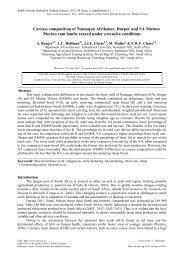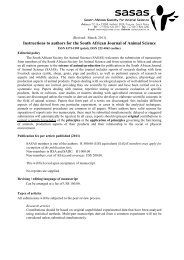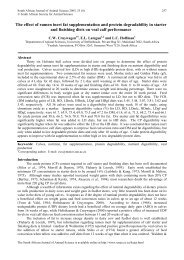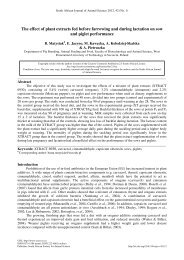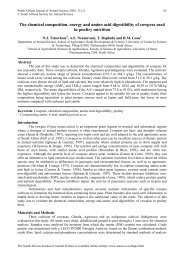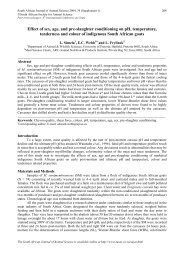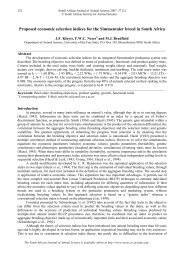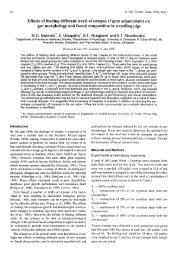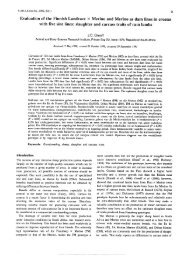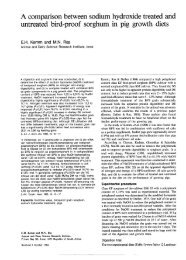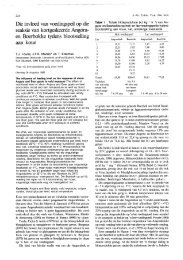Sensory and objective mutton quality characteristics of SA - African ...
Sensory and objective mutton quality characteristics of SA - African ...
Sensory and objective mutton quality characteristics of SA - African ...
Create successful ePaper yourself
Turn your PDF publications into a flip-book with our unique Google optimized e-Paper software.
South <strong>African</strong> Journal <strong>of</strong> Animal Science 2003, 33 (1)<br />
© South <strong>African</strong> Society for Animal Science<br />
56<br />
When the data were pooled for main effect <strong>of</strong> line, differences (P ≤ 0.05) were only observed in<br />
flavour intensity (Table 3). Meat from the positive line was rated more flavoursome (2.7) than the negative<br />
line (2.3). The slightly higher flavour intensity <strong>of</strong> the positive reproduction line could be the result <strong>of</strong><br />
differences in the fatty acid pr<strong>of</strong>ile (Table 11, Fisher et al., 2000).<br />
Table 3 Rank means (Means) for the sensory <strong>quality</strong> <strong>characteristics</strong> <strong>of</strong> M.semimembranosus as<br />
influenced by main effects <strong>of</strong> line <strong>and</strong> sex<br />
Line<br />
Sex<br />
LSD c<br />
Positive Negative<br />
Ram Ewe<br />
Aroma d 2.70 2.30 NS 2.30 2.70<br />
(5.98) (5.69)<br />
(5.71) (5.96)<br />
Initial juiciness e 2.60 2.40 NS 2.42 2.58<br />
(6.08) (6.00)<br />
(5.98) (6.10)<br />
Sustained juiciness f 2.68 2.32 NS 2.33 2.67<br />
(6.17) (5.98)<br />
(5.96) (6.19)<br />
First Bite g 2.68 2.32 NS 2.26 b 2.74 a<br />
(6.13) (5.98)<br />
(5.90) (6.21)<br />
Residue h 2.46 2.54 NS 2.53 2.47<br />
(5.69) (5.77)<br />
(5.75) (5.71)<br />
Flavour i<br />
2.71 a 2.29 b 0.40 2.39 2.62<br />
(6.25) (5.98)<br />
(6.06) (6.17)<br />
a,b Rank means in the same row with different superscripts are significantly different (P ≤ 0.05)<br />
c Least significant difference (P = 0.05), NS = Not significant (P > 0.05)<br />
d<br />
Aroma: 1 = extremely bl<strong>and</strong>; 8 = extremely intense<br />
e<br />
Initial juiciness: 1 = extremely dry; 8 = extremely juicy<br />
f<br />
Sustained juiciness: 1 = extremely dry; 8 = extremely juicy<br />
g<br />
First bite: 1 = extremely tough; 8 = extremely tender<br />
h<br />
Residue: 1 = abundant; 8 = none<br />
i<br />
Flavour: 1 = extremely bl<strong>and</strong>; 8 = extremely intense<br />
LSD<br />
NS<br />
NS<br />
NS<br />
0.44<br />
NS<br />
NS<br />
When pooled for ram <strong>and</strong> ewe effects (Table 3), differences (P ≤ 0.05) were found in first bite with the<br />
ewe group having the highest score (2.74) <strong>and</strong> the ram group having the lowest taste panel score (2.26).<br />
Therefore, meat derived from ewes was more tender than meat from rams. However, Ellis et al. (1997),<br />
found no palatability differences between sexes in meat <strong>quality</strong>. Results <strong>of</strong> the present investigation agree<br />
with findings by Jeremiah et al. (1998), who in a study comparing cooking properties <strong>and</strong> palatability<br />
attributes between 1660 lambs varying in chronicle age, slaughter weight <strong>and</strong> gender, found that meat<br />
derived from ewe lambs was more tender than roasts from rams. In this latter study these differences became<br />
more pronounced when secondary sexual <strong>characteristics</strong> (particularly as pertaining to the rams) had<br />
developed.<br />
The moisture, protein, fat <strong>and</strong> ash contents <strong>of</strong> the M. semimembranosus samples are presented in Table<br />
4. The meat from the four distinct groups differed (P ≤ 0.05) in moisture <strong>and</strong> lipid levels. The level <strong>of</strong><br />
moisture was highest in the PR group (ca. 76%) <strong>and</strong> lowest in the NE group (ca. 70%). The PR group also<br />
had the lowest lipid concentration (ca. 7%) <strong>and</strong> the NE group the highest (ca. 10%). No significant<br />
differences between the four groups were detected regarding the ash or protein levels.<br />
When pooled for sex (Table 5), the ewes had a significant lower moisture (ca. 71%) <strong>and</strong> higher lipid<br />
content (ca. 10%) than the rams (P ≤ 0.05). In a study by Ellis et al. (1997) carcasses from female lambs,<br />
compared to males showed thicker subcutaneous <strong>and</strong> greater intermuscular fat content. Observed trends by<br />
Jeremiah et al. (1997) further substantiate the fact that rams produce leaner carcasses than ewes. Tendencies<br />
in flavour intensity differences between ewes <strong>and</strong> rams suggested an association between the higher lipid<br />
content <strong>of</strong> the <strong>mutton</strong> derived from ewes <strong>and</strong> the flavour, aroma, initial juiciness <strong>and</strong> sustained juiciness<br />
ratings <strong>of</strong> their meat. The quantity <strong>of</strong> fat <strong>and</strong> its <strong>quality</strong> affect the nutritive value, appearance, processability,<br />
shelf life <strong>and</strong> palatability <strong>of</strong> meat. Therefore, fat is an important determinant <strong>of</strong> meat <strong>quality</strong>, <strong>and</strong> the degree<br />
<strong>of</strong> saturation <strong>of</strong> the fat contributes substantially to the sensory properties <strong>of</strong> meat (Rhee, 1992; Webb et al.,<br />
1994).<br />
The South <strong>African</strong> Journal <strong>of</strong> Animal Science is available online at http://www.sasas.co.za/Sajas.html



